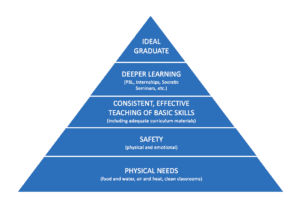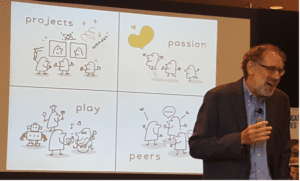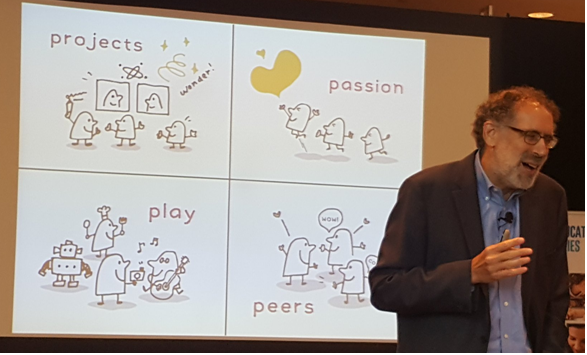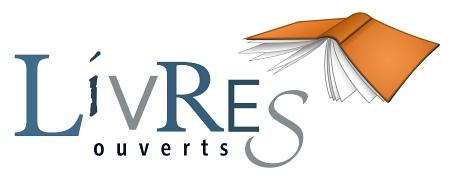What measures will be in place at our schools? Do we have to wear masks? Can we go to the bathroom when we need to? Drink from the fountain? What about exams? Lunchtime? Gym? Chess Club? Will secondary 5 students graduate this year? Will they get their Prom? Can I share my art supplies with others? What is permitted? What is not?
Since March 13th, 2020, these COVID-19 related questions have only multiplied, compounding worries and insecurities to create a bazillion other questions with very few answers. Similar to the movie “Groundhog Day”, we have been waking up every morning since March with the same questions and concerns, and even though the eve of schools reopening is upon us, it hasn’t gotten any clearer. With every new press conference there is more anxiety and yes, more questions.

Photo by Chris Colley
So, when faced with such an unknown future, how does one deal with learning? In the end, we need to be prepared for everything and anything. Boards, schools, students, teachers, and parents must accept that we are professionals, and through much thought and pining, we will ultimately do what is right for our students and their learning process. School is going to look and feel different this year – that is not in question – so what are some strategies and techniques we can believe in? Those answers don’t come from exams, worksheets, or even amazing Powerpoint presentations but rather from us making our students engaged learners! Simple enough, right?!?
If we look at the basic conditions for learning to take place, students need to feel safe and supported. In William H. Parrett and Kathleen M. Budge’s book, Turning High-Poverty Schools into High-Performing Schools, they explain that schools “…have long recognized the critical importance of providing a healthy, safe, and supportive classroom and school environment.” So be it at school, at home, or some hybrid of the two, those same conditions must apply for students to learn. It all starts with…
- Clear policies and procedures for student and staff conduct
- Frequent and effective communication between all stakeholders
- Attention to classroom/home management
Once these basic needs have been met in a learning environment, students are ready for the essential skills of innovation, risk-taking, and inquiry to become true learners. These essential skills form the foundation for all real learning to take place. Did you notice I never mentioned once, students become true learners from exams, textbooks, quizzes, or even fabulous worksheets? Be it online or in-person, implementing these structural pedagogical strategies is the golden rule for learning to take place.
For instance:

At the base of the pyramid are physiological needs, followed by safety needs, social needs, esteem needs, and finally, at the top, self-actualization—achieving full potential and the ability to fulfill creative activities. Bob Lenz and John Larmer. The Buck Institute for Education
- Keep it short and varied
- Keep the purpose at the forefront
- Keep tasks within learners’ reach
- Keep “teaching” to a minimum
- Keep assessment formative and on-going
- Keep praising the learning process, not the end game
- Keep documenting the process
- Keep them making, prototyping, exploring, and discussing…
However, all the structure in the world won’t keep students motivated if they are not connected to their learning.
Structure and routine are extremely important for learners but if experiences and interests of students are not woven into the learning process then their motivation to learn will surely suffer. So, how do you keep students motivated and engaged one, might ask? Caroline Knorr recently wrote for Common Sense Media, “focus on the skills kids are building, the value of seeing things through, and the feeling of accomplishment.” Furthermore, allow for the “…flexibility to go deep on topics kids really love. Build upon and extend what they’re learning with a natural connection…” to their lived experiences.
MIT’s Mitch Resnick has long believed that if we keep the kindergarten mindset throughout a student’s academic journey, we will in fact create life-long learners because learning should be fun! In his book, Lifelong Kindergarten: Cultivating Creativity through Projects, Passion, Peers, and Play, there are four “P’s” he presents:

Photo by Ministry of Education of the Republic of Belarus
PROJECTS: learn by doing
PEERS: learn from others and by teaching others
PASSION: do things you are interested in
PLAY: make it fun and make time to play
Instead of believing that we need to replicate our past educational structures we can stand poised for change: Change in how we educate; Change in what we teach; Change in the student-teacher dynamic. Learning happens best when students are engaged and motivated… and in charge of their learning process. No amount of institutionalized education will ever make a learner feel validated in their learning journey without their voice being heard. This is the time to give back to the student their own learning. Full stop!
Join the LEARN Ped team on Thursday, August 27th, 2020 from 3pm-4pm for an online session focusing on how to engage students with hands-on learning be it online or in person. < Register here >
****************************************
Knorr, C. (2020, August 03). Keeping Kids Motivated for Online Learning. Retrieved August 21, 2020, from https://www.commonsensemedia.org/blog/keeping-kids-motivated-for-online-learning
Lenz, B., & Larmer, J. (2018, October 12). Students’ Basic Needs Must Be Met Before They Can Learn Deeply. Retrieved August 21, 2020, from https://www.pblworks.org/blog/students-basic-needs-must-be-met-they-can-learn-deeply
Parrett, W. H., & Budge, K. M. (2020). Chapter 8. Fostering a Healthy, Safe, and Supportive Learning Environment: How HP/HP Schools Do It. Retrieved August 21, 2020, from http://www.ascd.org/publications/books/109003/chapters/Fostering-a-Healthy,-Safe,-and-Supportive-Learning-Environment@-How-HP~HP-Schools-Do-It.aspx
Resnick, M. (2017). Lifelong Kindergarten. Retrieved August 21, 2020, from http://lifelongkindergarten.net/





